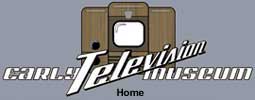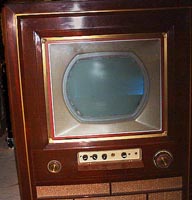COLOR TVCT-100 to PS38000
From early television to the present... and yes, the old CT-100 is still worth more than the new HDTV.  These are all quick shots taken with just a webcam. I've rolled up the rug and am placing the HDTV in the visual sweet spot. The CT-100 will take up residence in an honored spot across my small living room. Selected this HDTV set for the following reasons: (1) it has a direct-view CRT, which means superior resolution and greater viewing angle, (2) the tube has 0.78-inch dot pitch, which is visually better than any other HDTV considered, (3) the aspect ratio of the CRT is 16 x 9, which is the future of HDTV, (4) by definition it is NOT a 4 by 3 aspect ratio, which is what most HDTV sets on display in my area are, (5) it has circuitry built-in that receives and decodes high-definition broadcast signals, which for some unfathomable reason is not what virtually all other HDTV receivers contain, (6) this set also contains a satellite receiver as an integral element of the system, which means one doesn't spend four- to seven-hundred dollars more to watch over-the-air HDTV or satellite broadcasts, (7) it contains the video amplifier that Jeff mentioned he was designing in another story elsewhere on this site in 1999, (8) the dealer gave me the stand for free with the set, (9) Thompson-RCA dropped the Proscan line so it cost $500 less than a few weeks ago, and (10) I paid off the last of my back child support January 31, 2002!, which places me in control of my own destiny once more. Let's classify television today under three distinct modes of operation -- analog, digital, and high definition. Called 'analog' by marketing, this is the existing NTSC standard first defined July 1, 1941 with an update for color December 17, 1953. This service is scheduled to cease all broadcasts by 2006, but I'll have to see that to believe it. Second is the just-finialized ATSC 'digital' service. (FCC Docket No. 00-39 "We conclude that there is insufficient evidence to add COFDM and we therefore reaffirm our endorsement of the VSB standard.") Here it gets more complicated because there are digital broadcasts that are no more than digitized programs generated in and for NTSC transmission. Here are two basic modes, one digital and one analog, neither is high definition.
high-definition channel broadcasting in 16 by 9 aspect ratio. Notice the black bars left and right (a sort of vertical letterbox). This is the result of broadcasting a 4 x3 imago over a 16 x 9 HDTV channel.  aspect ratio of the CRT. That's because, just to add confusion, one can "fill" the screen with a 4 by 3 picture by stretching it both horizontally and vertically with a concomitant loss of much of the original picture. There is also a 4 x 3 "full" mode that stretches the picture horizontally only, for watching 16 x 9 'enhanced' DVD movies, but that's another story. Certainiy part of the reason is the attack. Since then and the loss of HDTV transmitters, only two channels are immediately available at my location -- UHF channels 44 and 56. Thus far, and it's just CBS and FOX that I have access to, CBS easily takes the gold ring for best HDTV images. "The Agency" is the crème de la crème for super realistic over-the-air HDTV. --Pete 19 Mar 2002 Operational CT-100 owner Nat Pendelton, who sparked my interest in HDTV during a conversation at Steve McVoy's museum last January, illuminated some of the twists and turns of high-definition technology in this recent email. To: dexnis60@yahoo.com Subject: Re: HDTV Date: Mon, 18 Mar 2002 14:17:17 -0500 Pete, HD is indeed cool. And you are right, CBS gets the gold ring in supplying the most programming in 1080i true HD. "The Agency," "The District" and "CSI" all look great in HD, plus football games. FOX only broadcasts 480p digitally in a 16 x 9 format (This is what a current high end DVD player can deliver). Try tuning in when both Fox and CBS are showing, and you will quickly notice the greater resolution of CBS. NBC also uses 1080i, but thus far only does the Leno Tonight show. There's also a medical show Monday nights at 10. NBC did broadcast the Olympics from Utah in HD.You could see the snow and all the scratches on the ice rinks. ABC is a renegade, with a 720p system. I can't tell much difference between it and the 1080i on my 34-inch Proscan, but I bet a huge screen TV would show it. ABC runs a lot of James Bond movies (Saturdays) as well as some of the Disney Sunday night show in HD. The also have a few dramas like "Philadelphia." Outdoors scenery is the best, since there is so much detail. On DirecTV they have HD Net, which shows sports as well as outdoor nature movies. All programs on that channel are HD, 1080i. Dallas Maverick's owner Mark Cubin put it together. Both cityscapes and countryside show up great on the travelogues that are shown on the channel. If you subscribe to HBO on DirecTV, the main HBO east-coast feed is also shown in HD for about 60% of the programming. This is mostly movies (knockout, it's like going to the mall's multiplex, except without the noise or smell of popcorn) and a few HBO made shows like the "Sopranos." Right now, I have the CT-100 attached to the Satellite receiver so I can feed it good programming. The satellite receiver is switchable from NTSC outputs over to ATSC component videos for the HD monitor. A sharp, digital picture on a CT-100 was unheard of in 1954. 
|


